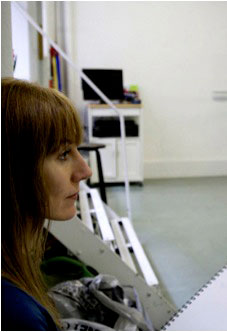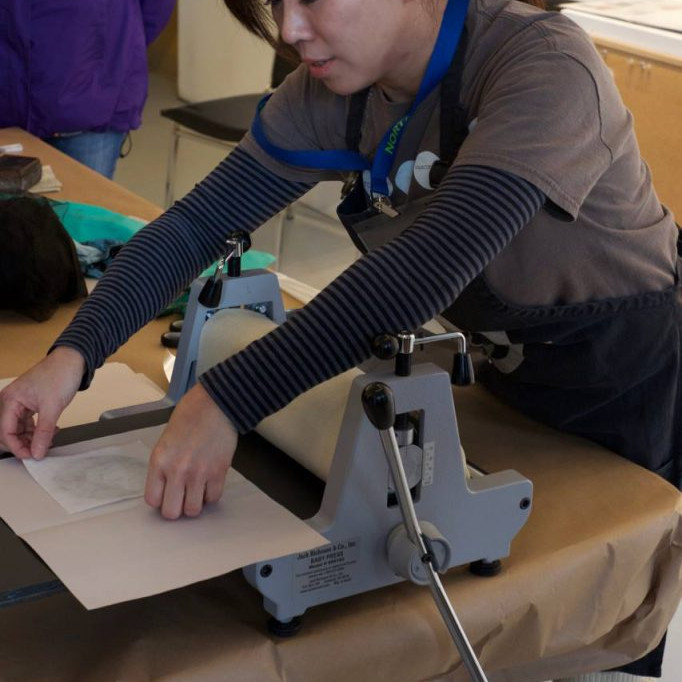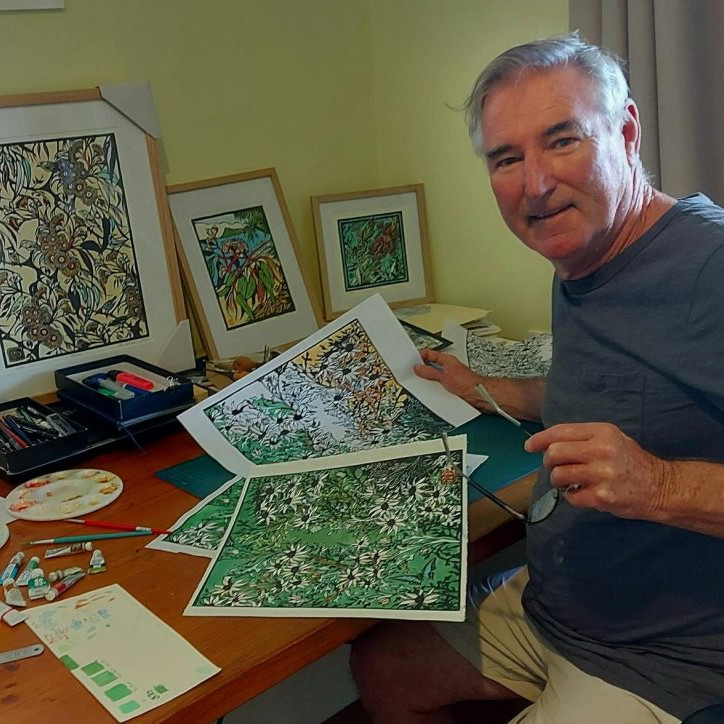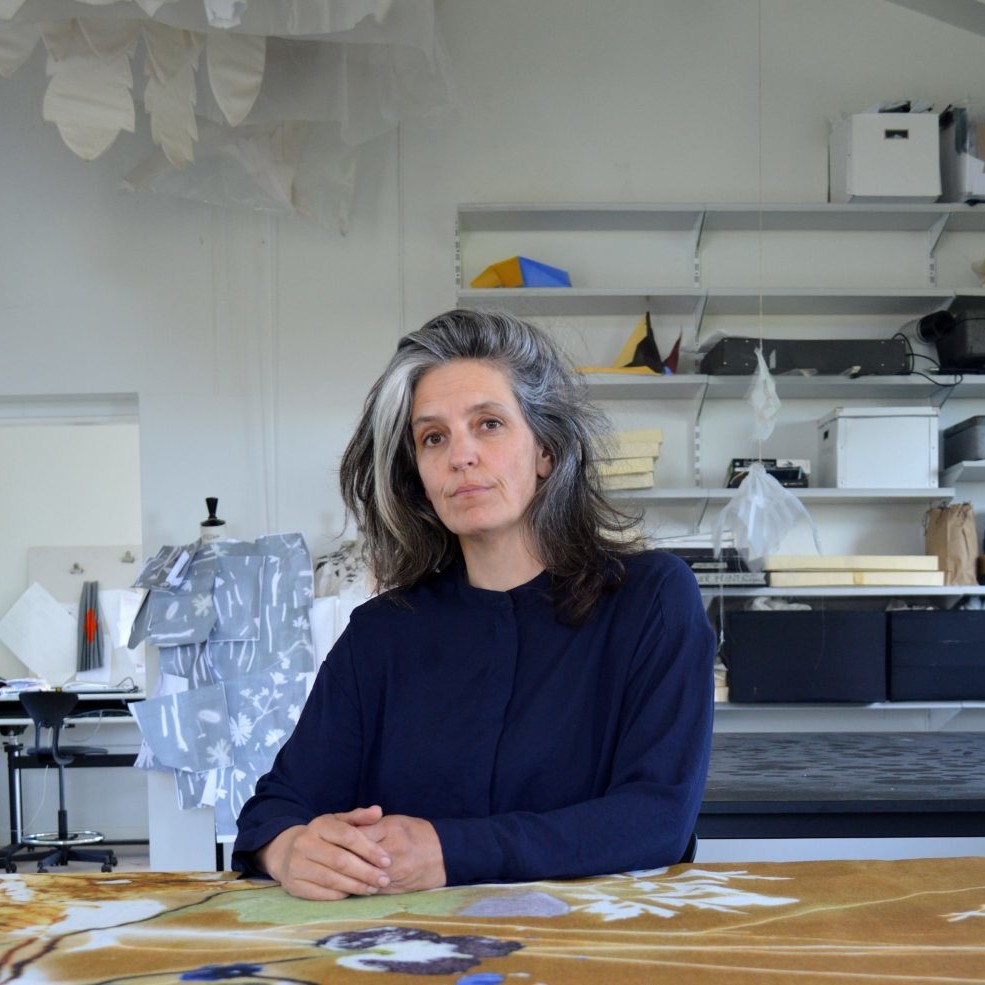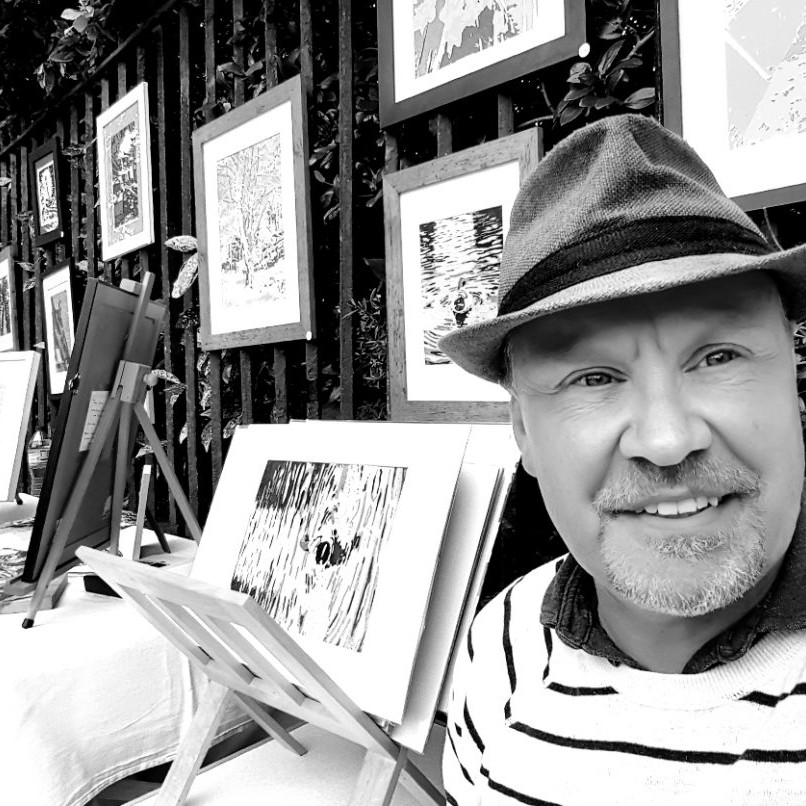Debra Luccio Printmaker - Victoria, Australia
Your current body of work was done from within two studios, The Australian Ballet studio and your own studio both in Melbourne, Australia. Can you explain?
Over the last 2 years I have spent time at The Australian Ballet studios, drawing and sketching the dancers in class and in rehearsal. I also took photos to be able to capture additional information for more detailed monotypes and paintings. Back in my own studio I used all of my reference to create drypoints and etchings, monotypes and paintings of the dancers.
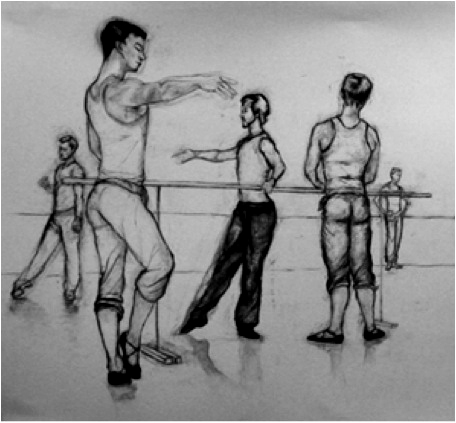
‘Time Lapse’ Detail
How were you lucky enough to be given this amount of sketch time with The
Australian Ballet company?
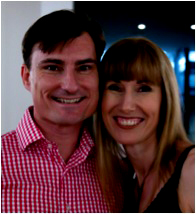
David McAllister with Debra Luccio
A lovely gentleman, Ian McRae who
was recently retired from the board of
The Australian Ballet visited one of my exhibitions. He enjoyed my work and introduced me to David McAllister.
How often did you attend their practice sessions?
My first stint with The Australian Ballet was for 3 weeks early in 2011. I have since been back a couple of times for a week at a time.
How did the dancers feel about your presence in their studio?
The dancers were happy for me to be there. I quite literally sit in a corner on the floor so as not to interfere with them in any way. In all of my experiences I have found the dancers to be incredibly warm and friendly.
What comments did they make about your work of them?
The dancers are always very kind. Not many have time to look through my sketchbooks while I am in their studios as they move on to their next appointment. I don’t take breaks either. I continue to draw in different sessions which means there is not much time for dancers to see the sketches. However I do try to take some of my finished artwork in to the dance studio’s to show the dancers what I am working on and how they have inspired me. I am always surprised at how much they connect with the work. Some of the dancers are very insightful. I am very lucky to have this response and experience.
This isn’t the only ballet studio you have sketched in; can you expand on your ballet sketching in both New York and Brisbane?
In 2007 I spent a lot of time watching the New York City Ballet. I drew the dancers in rehearsals and performances. We were invited to watch a class at the School of American Ballet as well. While in New York I was introduced to the Tiffany Mills Company, a contemporary dance group. I drew and photographed them in final rehearsals of ‘LandFall’. I then spent a couple of years creating artwork of the Queensland Ballet and in 2010 worked with the Rebecca Kelly Ballet in SoHo, New York.
Why Ballet dancers?
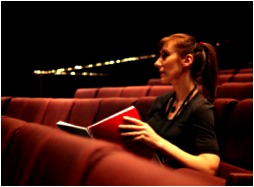
I have always had a great interest in the human form. Before our trip to NYC in 2007 I had not considered dancers as a subject. In hindsight, I don’t know how I could have missed the connection. With dramatic lighting and beautiful,
strong, muscular bodies, it seems obvious that dance would be a focus for my artwork.
Whilst in New York I learnt about the NYC Ballet. I had not considered working with a ballet company because I was concerned that traditional movement such as the pointed toe, the plie and the pirouette may not be expressive enough to satisfy me, but this company was different.
The philosophy of the NYC Ballet was that the body of the dancer was an important aspect of the expression of the dance. The Ballet Master, Mr Peter Martins referred his dancers to Michelangelo’s ‘Slaves’. I became hooked. I also quickly learned that watching highly talented dancers performing traditional ballet is beautiful and expressive – truly inspiring.
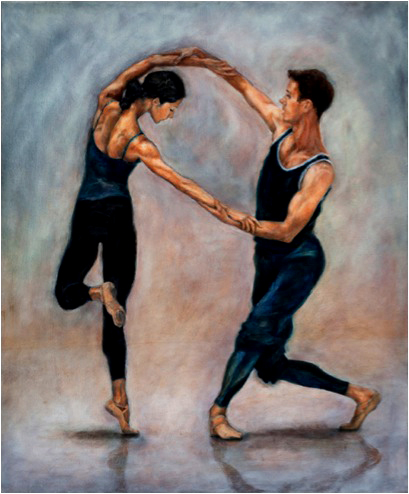
‘After the Rain’
Tell us about the marking on the background of your prints and why you do this?
For my most recent drypoints I used older copper plates to scratch my images onto. I felt the accidental scratches and marks on the plate added movement and depth to the image of the line of the dancer.
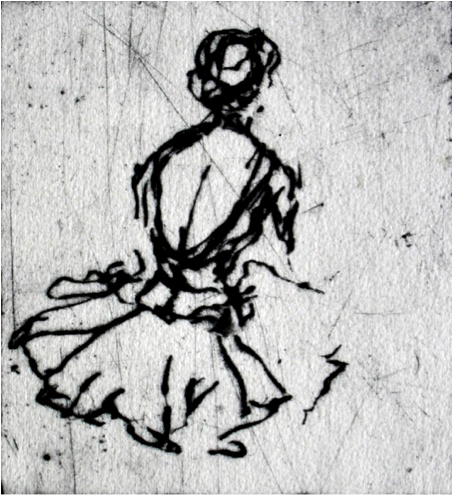
‘Tutu in Repose’
‘Nanasca’- Monotype on Velin Arches paper
When I am working on my monotypes I find that I am working with great determination. I want to keep my lines and marks fresh and energetic. Even from my first marks of rolling thin layers of colour onto the plate, I have decided to allow those marks and movements to remain evident to give a sense of energy.
The physical process of making a monotype allows me to push the artwork even further, letting the marks created by the roller emphasize the movement of the dancer. Working with a sense of self-imposed urgency in the studio has helped me to not ‘over-think’ the artwork and has allowed the marks I create to remain fresh.
‘Nanasca’ was inspired by a dancer in the background of one of my photos of Madame Butterfly rehearsals. Karen Nanasca’s pose caught my eye. There was something special and fleeting about her – I could almost sense her breath as she pushed her chest forward. I felt that the energy of the monotype might help me capture the ‘moment’ while still suggesting movement and space in the image.
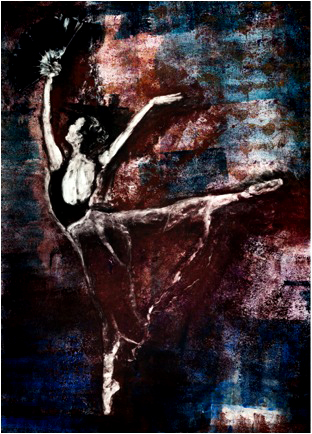
Monotype ‘Nanasca’
‘Ty’ – Oil on linen
I thought this image was perfect for an oil painting. I wanted the light of Ty King-Wall’s shoulder to be luminous and I wanted time to capture the musculation of his neck and face. This to me is a very strong moment it time. Even though the dancer is in ongoing movement and this was only a second in a performance, it was very powerful and resonated with me.
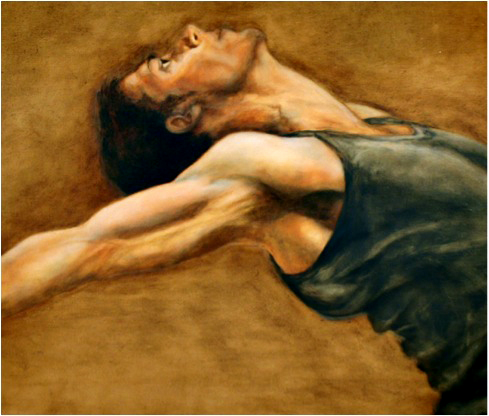
Oil on linen ‘Ty’
‘Timelapse’ – Charcoal on paper
I wanted to draw with charcoal. It is charcoal rub-backs that inspired me to work with monotypes. The rub-back method involves covering the page with charcoal and using an eraser to sculpt out the light of the image.
I was very lucky to be drawing a class that David McAllister, Artistic Director of The Australian Ballet, ran. My idea with ‘Time Lapse’ was to capture a Ballet Master teaching a class, moving throughout the studio while the students watched him and responded to his instruction. The Ballet Master is repeated 3 times in the image and one of the students is also repeated, to illustrate the lapse of time.
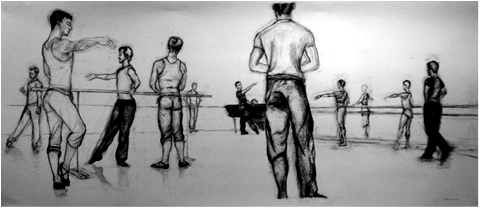
Charcoal on paper ‘Time Lapse’
As I drew I allowed myself to make mistakes and correct, so that the ‘pentimento’, the marks underneath, would act as a memory of movement.
Can you explain the special qualities that dancers give to your life drawings??
When the dancers are rehearsing their entire body expresses the emotion of the performance. When I sit in the studio watching them I see every part of their body responding to an emotion, from their face to their fingertips. They have a great ability to physically extend their bodies into shapes that communicate so much. It is important to me that I capture something expressive or dynamic in my work. To be inspired by the extensions and forms that the dancers can physically express with their bodies is exciting. When watching the dancers I see lines and shapes that inspire me so I try to capture these in my own work to create movement and dynamics.
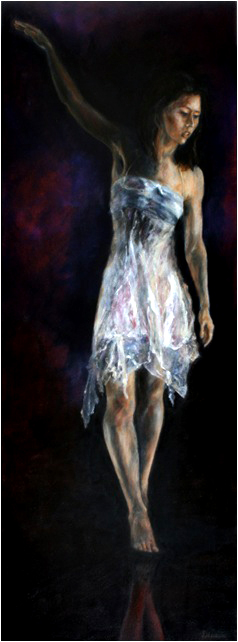
‘Laura’
Dance is an art that encompasses many of the senses. A performance can steal you away into another world filled with music, light, colour, movement and emotion. A performance is a highly visual experience and even though the experience can live with you for a lifetime, it can only be seen for the time you are at the performance. I hope that my artwork contains a sense of my own experience.
For me personally, before anything, dance is about the body – the dancer’s ability to use their body to express so much.
Tell about the type of sketchbooks and pens/ pencils you use and the method of drawing you take?
I use acid-free spiral bound sketchbooks in A4 and A3. I have a large variety of drawing materials to allow me to use what I most feel comfortable with on the day. I have graphite pencils, mainly 2B and 4B, black fineliner and ballpoint pens, sanguine conte, willow charcoal and compressed charcoal, normally ‘soft’.
When I draw the dancers I barely look at the page. My eyes watch the dancers and my hand draws the lines that I see.
Can you explain the three printing processes (briefly) Monotype, Dry point, Etching.
Monotypes are a form of printmaking – a one-off piece. No scratches or marks are made on the plate. The copper sheet is cleaned once the monotype is printed, and a new monotype may be made.
The monotype is known as the most painterly method of printmaking. There are many techniques and methods of creating monotypes. I use a rub-back or reduction method and was inspired to experiment with layers of colour after spending time with the Renaissance paintings in Florence and Paris in 2005 and being fascinated with their glazes. I wondered if the heavy etching inks would retain some of their individual qualities if I layered them together on a sheet of copper, and they do.
I roll thin layers of coloured rich sticky etching ink onto a copper sheet. I then wipe away the ink and push it around with a cloth wrapped on my finger to create the light, tone and form the dancer on the plate. The copper sheet is then run through a printmaking press with a piece of prepared Velin Arches paper laying on top of it. The image is transferred from the plate to the paper.
I never know exactly what will happen – there is a strong element of chance involved, but the process creates a sense of urgency and immediacy that pushes me as an artist.
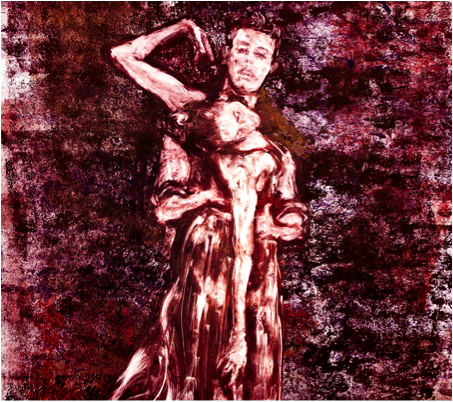
Monotype ‘In Red’
Drypoint is a method of printmaking. No acid is used, hence ‘dry’. The marks made are reliant on the direct pressure of the artist scratching onto the plate.
Using my drawings from the ballet class, I have scratched the drawings directly into a copper sheet. The copper sheet is then inked up by hand with rich, sticky etching ink. It is wiped, leaving ink in the scratched lines and on the burr of the scratched lines and removing the ink from the rest of the plate.
A piece of prepared paper, soaked and blotted dry, is placed over the plate and run through a press. I use Velin Arches – it is a beautiful paper with wonderful qualities. The line is transferred to the paper. The process can be repeated and the image editioned.
My Etchings are made by scratching the drawing onto a protected sheet of zinc. The line is scratched through the protected layer. The zinc plate is placed in acid and the acid eats into the scratched line. The plate is then inked up and wiped, leaving only the ink in the lines created by the acid.
A beautiful piece of prepared Velin Arches paper is placed over the plate and it is run through a press. The line is transferred to the paper. The process can be repeated and the image editioned.
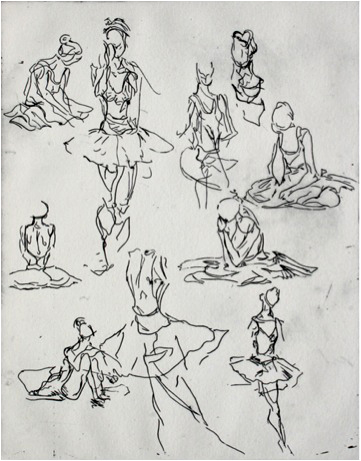
‘Tutu in Rehearsal’
The drypoint line often appears a bit furry due to the burr, like a line of charcoal. It is rich and very interesting. The etching line is clean as the acid eats away the metal, rather than it being gouged into and bits of metal being lifted as in a drypoint. The etching plate is also lovely to draw on as it doesn’t require any pressure from the artist’s hand. The drypoint method is a lot more difficult to scratch into the plate but gives a raw, gutsy line.
You are also taking classes at the National Gallery of Victoria (International) these classes will coincide with The Australian Ballet’s 50th Anniversary and Ballet and Fashion and exhibition at the NGV. Tell us about these classes?
Event Code: P1302
Information & bookings: 03 8662 1555
Sun 3 Feb, 10.30am–2pm: Costume Drawing
Be inspired by the costumes of Ballet & Fashion. Discover how to capture light, shape and form drawing directly from the costumes. Improve your skills and create drawings that capture proportion, craftsmanship and the attention to detail that adds to the story-telling of the dancers on stage and the way the costumes were designed to enhance the performance of the dancers.
Sun 10 Feb, 10.30am–2pm: Life drawing with nude dancer
Working with a ballet dancer and using the charcoal rub-back technique you will create a large resolved figure drawing that displays depth, form and dramatic contrast. In addition, you will discover how to make a series of quick expressive drawings that capture the dancer with power and expression. There will be an introduction and a study component of examples at the start of the class. After the gestural drawings we will move into the longer pose. Covering the page with charcoal, you will then erase into this covered charcoal ground to lift out the light from the dark to create beautiful contrasts of modeled flesh tones. In varying degrees of intensity, you will then apply more charcoal to create depth and add structure to your drawing.
Sun 17 Feb, 10.30am–2pm: Introduction to monotypes – Inspired by Degas
Monotype is a seductive, painterly and powerful method of creating art. Degas created some of the most memorable, striking and powerful images of dancers in the history of art. The method of monotype was one of his favourite mediums. Learn how he did it, and why he enjoyed the technique. You will explore three techniques of monotype and learn how to make monotypes at home. Look at examples of artwork and discuss additional techniques and ways you may create monotypes in your own home, with or without a printing press. If you have had the opportunity to attend the earlier classes, bring in your drawings to work from. Otherwise we will provide all types of materials for you to draw from, including costumes and Degas images.
Debra, where to from here?
I am continuing to work with The Australian Ballet and will also work on some separate projects. I believe that working with different mediums and subjects will help keep me fresh and motivated, and bring a different perspective to the artwork I create with the dancers. One such project I am working on this year is landscape photography to be exhibited at the Maitland Regional Art Gallery in October 2013.
Gallery details
Melbourne:
Port Jackson Press
Steps Gallery
Sydney:
Rex Livingston Art Dealer
Contact details
P: 0448 026 643
W: www.debraluccio.com
Debra Luccio, Victoria, Australia.
Interview by Deborah Blakeley, January, 2013
Think a colleague or friend could benefit from this interview?
Knowledge is one of the biggest assets in any business. So why not forward this on to your friends and colleagues so they too can start taking advantage of the insightful information the artist has given?
Other artists you may be interested in:


